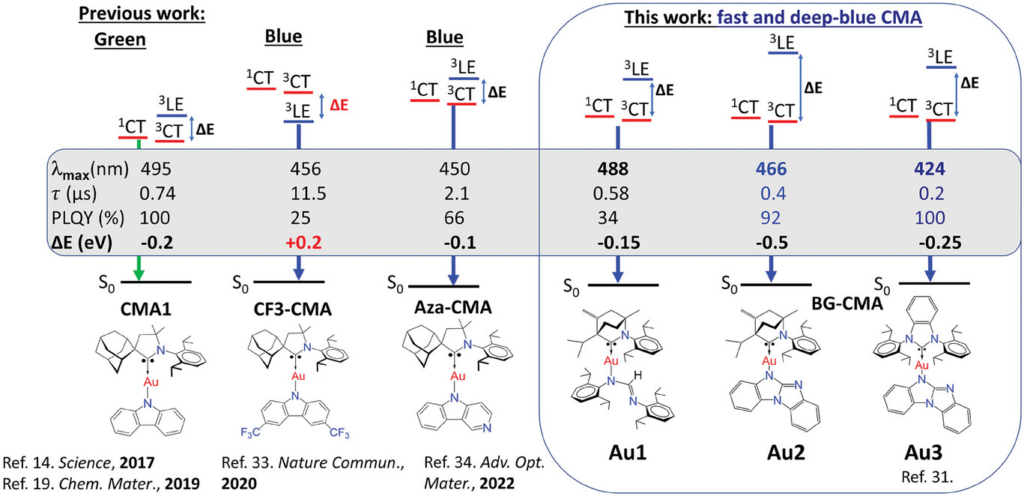In a recent study published in Advanced Materials, researchers have achieved a breakthrough in the development of deep-blue organic light-emitting diodes (OLEDs) using carbene-metal-amide (CMA) complexes. This novel class of materials, characterized by their linear geometry and rigid benzoguanidine amide donor, promises advances in both efficiency and stability for OLED applications.

The research, spearheaded by Alexander C. Brannan and his team, focuses on the synthesis and characterization of linear gold complexes of the CMA type. These complexes were designed with various carbene ligands and a rigid benzoguanidine amide donor. The key innovation lies in the ability of these materials to emit deep-blue light with remarkable efficiency and stability. The emitted wavelengths of 424 and 466 nm are achieved with 100% quantum yields across all tested media. This performance is attributed to the thermally activated delayed fluorescence (TADF) originating from a charge transfer state, which boasts an exceptionally short excited state lifetime of just 213 nanoseconds, resulting in rapid radiative rates.
The researchers successfully fabricated highly energy-efficient OLEDs with these materials, achieving deep-blue electroluminescence at 416 and 457 nm. The practical external quantum efficiencies (EQEs) reached up to 23% at 100 cd m−2, with impressive color coordinates of CIE (x; y) = 0.16; 0.07 and 0.17; 0.18. The operating stability of these OLEDs is unprecedented, with a reported LT50 (the time to reduce the initial brightness to 50%) of 1 hour for deep-blue CMA emitters.
The study underscores the importance of molecular design in achieving these results. The linear geometry of the CMA complexes ensures efficient mixing of singlet and triplet excited states with charge transfer character. This is facilitated by the high spin-orbit coupling values of the coinage metal atoms and the rotational flexibility between the π-donor (amide) and π-acceptor (carbene) ligands. The choice of benzoguanidine as the amide donor and various carbene ligands allows for fine-tuning the photophysical properties, achieving the desired deep-blue emission with fast radiative rates.
The key challenges in blue OLED development are:
- Color Efficiency and Stability: Achieving high efficiency and stability in blue OLEDs has been a longstanding challenge. Blue light requires more energy to produce than red or green light, leading to faster degradation and shorter device lifetimes.
- Quantum Efficiency: Efficient light emission in OLEDs often involves managing the balance between singlet and triplet states. Materials that can utilize both effectively (like TADF materials) have been pivotal in pushing efficiency boundaries.
- Operational Lifetimes: For practical applications, OLEDs need to maintain their brightness and color purity over extended periods, which has been particularly challenging for blue emitters.
Reference
Brannan, A. C., Cho, H.-H., Reponen, A.-P. M., Gorgon, S., Phuoc, N. L., Linnolahti, M., Greenham, N. C., & Romanov, A. S. (n.d.). Deep-Blue and Fast Delayed Fluorescence from Carbene–Metal–Amides for Highly Efficient and Stable Organic Light-Emitting Diodes. Advanced Materials, n/a(n/a), 2404357. https://doi.org/10.1002/adma.202404357

